#it's like 10% somewhat reasonable depictions of the wealthy bits
Explore tagged Tumblr posts
Text
Not just California and not just L.A. It needs to be the Westside; that's the white neighborhood where the producing screenwriters live and influencers never leave. They already misrepresent the rest of L.A. where the rest of us live.
"I hate how American media will just make up a European nation rather than do any research, so I'm going to get back at them by writing a story set in a fake American state" like, do you have the slightest idea how much American media is set in a geographically impossible fictional small town located in no particular state and characterised entirely by some guy from Los Angeles' collection of half-remembered stereotypes about the American Midwest? They've already got the "badly inventing fictional parts of America" bit locked down.
No, if you want to play the Uno reverse card on American media, what you need to do isn't to make up a fake state: you specifically need to wilfully misrepresent southern California.
#nyxie is a californian#nyxie is an angeleno#they never drive east of the 405#and complain about how fake everyone is#NO SHIT WHAT DO YOU THINK HAPPENS WHEN YOU LIVE IN THE FAKE PART OF TOWN#ahem#anyway#yeah most of L.A. isn't actually represented well in the media either#it's like 10% somewhat reasonable depictions of the wealthy bits#then 90% white fear stereotypes about all the POC neighborhoods#ffs people talk about my neighborhood like it's the ghetto#not saying we don't got problems#but i'm not walking through a gangridden hellscape#when i walk with groceries at night#which is a thing i've done#much to the shock#of people who don't live here#but only know the place#from movies and stereotypes
48K notes
·
View notes
Note
ok wait i'm a bit confused..,,,, lauren really gave a big fuck you to any other kinds of witcher lore and characters and is just not very talented but is she a actually bad person? bad meaning racist homophobic ableist etc? i can not find anything good and you always have 12/10 chefs kiss info (sry about my shitty english)
she’s not done anything racist personally, but in regards to racism i’d like to point out how all of the black actors/characters are treated in twn. they all were relegated to antiblack tropes:
dara was black best friend trope (”a black character whose role either A) revolves almost entirely around a white character or B) serves as a conscious effort for a white character/writer to appear inclusive”),
queen eithne was magical n*gro trope (sorry that’s the name for the trope but i don’t feel like i should be saying that word) (”in order to show the world that minority characters are not bad people, one will step forward to help a "normal" person, with their pure heart and folksy wisdom.”)
the dryads in general were depicted very stereotypically as somewhat hollywood natives (” typical depictions will show the (usually dark-skinned) natives as unkempt and scantily clad, decorated with tribal face paint and brandishing spears or bows”) and iirc some the actresses who played most of them were white (anneke weerts, nóra trokán are listed on imdb as being dryads, and i do not think they are black?) yet they all had dreadlocks... it’s uncomfortably close to blackface. also my question is why did “people who live in a large forest and are close to nature” garner one of the main black actresses involved in twn and the whole cast to have dreadlocks and spears (when dryads never used spears in the books)?
fringilla vigo was just straight up evil and does human sacrifice now for some reason, with no personality but being evil and mean to yennefer, who is played by white-passing anya chalotra. in canon, she wasn’t even evil, but they made her a villain for... what reason, exactly?
vea and tea were... okay... “sexy women who don’t speak a lick of the common language” was already a bad trope introduced by sapkowski, but sapkowski never specified that they were black (they’re described with blonde hair iirc, i believe they were based upon the ancient steppe peoples), so taking that trope and saying “oh hey, these two are sexy warrior women who don’t speak any english, they must be black!” is extremely uncomfortable to me
all the other black actors were relegated to background characters that have extremely few lines and appearances.
racism that isn’t antiblackness off the top of my head includes:
they took the depth and emotion out of toruviel’s character, which strikes me as poor treatment of people of color because i believe that natasha culzac, her actress is mixed race (half caribbean).
casting vilgefortz (VILGEFORTZ... the r*pist and main villain of the entire series) as a man of color, and casting very very few men of color in other roles besides this one... like, let me repeat again, VILGEFORTZ...
yennefer is constantly shown naked and in pain in scenes that just were not canon at all, they cast yennefer as a woman of color and then made her naked and in pain MORE of the timem
since all of this racist treatment and also tokenization of characters is in twn, and lauren is the showrunner of twn, i believe she should answer for this, trying to appeal to a larger demographic to get more money.
her husband is michael hissrich, who won primetime emmy awards 3 times, which leads to how i believe that lauren got her position out of nepotism
and the two are filthy rich, i mean they listed their house in hollywood for $2 million
tldr she’s not done anything horrific, but she’s just another wealthy white woman. she’s not your ally or my ally, she doesn’t care about representation like she pretends to. she’s a very rich cishet white woman who can’t write, and attempts to appeal to more diverse demographics in order to rake in more cash
130 notes
·
View notes
Text
Moonlit Throne historical clarifications/references
i want to accurately represent the history from the joseon era, but sometimes for the sake of story/ease of accessibility, things had to be minorly changed. the following is a list of creative choices/changes i make in the writing of Moonlit Throne, as well as further information about the history/culture that i’ve found through my own research 💓 i hope this can also provide some more context for those interested. this list is to be updated as the series progresses so i always recommend you read the latest drabble before checking for more info here for risk of spoilers. please correct me if i get any info wrong!!
for even more information about the world, check out the tag #moonlit history!
last updated: after drabble 43!
new information for the latest drabble will be under the moon.
king gwanghae - as mentioned in the line “gwanghae flow” & in the rest of the MV, Daechwita was inspired by this historical king & the movie about him. Moonlit Throne is not inspired by any king. any event that is similar is purely coincidental!
topknot - various sources state that only married men were allowed to wear their hair up, though this is often not the case in popular korean media. even though Yoongi is unmarried, i chose to pay homage to the daechwita MV & give him a topknot throughout the series. *** same goes for the blonde hair color!
months - traditionally, they followed the lunar calendar in the Joseon era. but i thought that that would be a bit difficult to explain for modern audiences so i am choosing to use the months/modern equivalents of dates.
yoongi’s scar - i am aware that Scarlet Heart Ryeo depicts the facial scar as a reason that someone could not become king. i haven’t found much on this in the way of historical sources, so it’s not a factor in my series!
uinyeo - aka. reader’s mom, and eventually reader herself. at the time, it was believed that women could not be treated by male doctors due to the shame of showing a man their body, even in a medical context. this position was generally occupied by a woman that was ranked below middle-class & commoner (think merchants/fishermen/etc.) as it was not a very desireable role. reader’s mom, Eun-a, is the head uinyeo, which is why she is called “su-uinyeo-nim” by others.
***i haven’t found any information that says men couldn’t be treated by women due to the Confucius beliefs, so at least in this story, reader helps out the male physicians from time to time.
eunuch - eunuchs were impotent or castrated men (had all or part of their genitals removed) who worked within the palace walls, serving and attending the royal family. they had their own hierarchy, like head eunuch, etc. it was possible for eunuchs to marry & have families of their own.
***Eunuch Kim has a 🍆! it’s just his testicles that were removed.
yoongi’s name - technically kings use temple names that end in jo or jong instead of their given names, but i’m keeping it as Yoongi!!
age - it’s revealed in the march 1858 drabble that Yoongi is officially turning 10 years old that year, but this is in Korean age. his birth year is 1849, which would make him 9 years old in age as we know it internationally. Korean tradition dictates that people age up at the start of the new year (Jan 1), not on their actual birthday. traditionally, they also add an extra year as they consider the baby 1 year old at birth, not 0 years old. to do the math, reader is two years older than him, which would make her born in 1847 & turning 12 that year!
*** the average life expectancy around that time was ~35-40, so their understanding of a teenager would be very different than ours, at least in terms of maturity. thus, even though the main characters are relatively young by today’s standards, i’ve written them to come off as older. UPDATED INFO: it seems court ladies could live up to rather elderly ages, even up to 70, so i’m not sure if the earlier statistic was just mainly for men.
birthdays - i couldn’t find any information about whether they celebrated the actual day of birth as well back then, only about 100 day milestones, etc. but it is part of Korean culture to celebrate the birthday in modern times, so i kept it in.
jeonha - similar to mama, this is how you refer to the king as an equivalent to “Your Majesty”. wangseja-jeonha is the full title for the crown prince. usually people just call him seja-jeonha.
women’s rights - how much freedom you have kind of depends on what rank you are. most of the upper court/noble ladies (yangban) are born & raised within the palace. they were very, very rarely allowed to leave (& if they were married off, then they would have to leave with like guards/people with them). it’s unfortunate but they were treated like property, passed off from father -> husband. from what i can gather, the lower ranked women (like the uinyeo) had a bit more liberty about going into town (or at least ive seen in media), mostly bc no one cared about them.... sad truth but truth nonetheless.
king’s authority - even though the king is the ruler of the entire land, he doesn’t have absolute authority over everything. generally kings in the joseon era had to listen to the advice of the court officials if they thought he was making the wrong choice.
Minister Choi’s execution - so actually there were several types of executions for people of different ranks. someone of Minister Choi’s status likely would have been given a less gruesome death via. poison (sasa or 사사). but i’m keeping it as a beheading to pay homage to the daechwita MV!
***i also came across an article that said only royal blood could be spilled on the palace grounds so i’m not 100% sure where the public execution square was located, only that there was one & it was separate from the palace. also a lot of dramas seem to ignore this rule, so i’m not sure.
perfume - this existed back then! along with cosmetics. they were a luxury item for mostly the upper class, but they definitely existed.
Queen Jeonghui’s birthday - fun fact! i borrowed this real life queen’s name first, for drabble 3. then i found out, it just so happens that her real birthday falls in November as well. it was a total coincidence haha.
OC’s outfit/hairstyle - this is what she would have worn!
palace - the layout of the series setting is loosely based off Gyeongbokgung Palace! if you look at the map, i’ve set the private gardens at #24 (though the position of the island is different than how it looks in the map. it’s instead from the right side going towards the left), Yoongi’s private residence is #25. reader is moved into #23. #26-28 are libraries, which includes the crown prince’s private library.
*** also the palace is much bigger than you might imagine so to get anywhere takes some time & a bit of walking!
jipgyeongdang (집경당) - #22 on the map. along with #23 (below), were traditionally houses for concubines & palace maids before Yoongi moved them.
hamhwadang (함화당) - #23 on the map. where reader lives post December 1868.
sanggung - the highest rank available for women who served the palace/royal family. a woman could become a “favored sanggung” if she slept with the king, but not a proper concubine. normally from the “commoner” class.
sangmin - “commoner” class. made up about 80% of joseon’s people. were the farmers, fishermen, laborers, etc. these were the people that paid taxes and were ruled over by the nobles!
cheonmin - the rank below commoner, described in English as “vulgar commoner.” the upper classes considered these people “unclean.” among their numbers were butchers, sex workers, performers, shoemakers, and yes, uinyeo. they were normally given little to no respect at all within society.
concubine - women that had the honor of sleeping with the king. concubines had their own ranks within them as the king usually had many (think around a dozen). more info.
town - from what i can gather, directly outside of the palace is a small town. if you think of the Daechwita MV, it’s like the town that Yoongi walks through when he has black hair. this is where mostly people of the middle/lower class, like sangmin & those below that, live.
chuseok - Korean harvest festival! it means “autumn evening with the brightest moon”. it’s usually celebrated on the 15th day of the eighth month in the lunar calendar. that would put it anywhere around sept 9-oct 2 in our modern calendar depending on the year!
yangban - these are the “ruling class” or gentry of the joseon era. generally means their families own land, are somewhat (or very) wealthy, and they are well-educated. (think Mr. Darcy, for a British equivalent)
why does no one recognize the prince in town? - with a lack of access to pictures & internet, it was common for the normal citizens of the country to not know what their monarchs looked like. generally to identify people & rank, they had to rely on appearance. gold was a color only reserved for royalty, so only the king & his sons could wear the royal robes with gold embroidery. once Yoongi takes off those robes, it’d be hard to identify him from among regular yangban!
jeon - these are bits of shrimp/vegetables/fish/other small things that are deep fried in egg batter!
nokdujeon - this is like a small, savory pancake made with, you guessed it, mung beans!
Chun-ja calling Eunuch Kim “Kim-nim” - look. i’ll be straight with you i have no idea how a commoner would refer to a eunuch. i’m flip-flopping between his title (which i also cannot figure out bc idk which of the 18 political ranks he would be, but not for lack of trying y’all T_T) & his name with the respectful -nim. so just to be safe, i’m going with it.
***i also am not 100% on this, but i believe Eunuchs rank higher than commoners because they work in the palace? which is why Eunuch Kim uses “-ssi” for her.
hangul & hanja - so the Korean alphabet as we know it is called hangul, and it was invented in 1443. in the past, they used to use hanja, Chinese characters, to write documents.
female literacy rate - as related to above, it was rare for women to be able to read/write even up until the late 19th century. they weren’t allowed to learn hanja at all & only around 4% could learn hangul. of those 4%, it was mostly noble women, who received good education to be better wives.
***books were then thus read aloud by those literate to crowds, so people could still enjoy stories.
face - the concept of “face” is very much rooted in Asian culture. in Korea, it’s called chemyon, & is basically related to your reputation + how others see you. you can lose, build, or gain face through your actions or what rumors of you spread. for example, if parents have children with bad grades, they + the child lose face. people should strive to do things to build their family’s honor & face up. i’ve experienced firsthand how people go to sometimes extreme lengths to “save face” as the term goes. basically, if you’re going to do something shameful, it’s better to do it where no one can see. (this concept isn’t going to have a huge influence in the series, at least not so far & i use it rather lightheartedly in October 1865 but i just thought that it’s really interesting + important to know about Asian culture!)
French expedition to Korea (Byeong-in yangyo) - in October 1866, the second French empire tried to invade Korea (or Joseon as it was called at the time) because the king at the time executed seven French missionaries. after several months of fighting, Korea won with only four soldiers killed & 3 wounded (compared to France: 3 killed, 35 wounded). Joseon was able to stay relatively isolated from all the other countries, continuing the practice of isolationism.
gossip - i couldn’t find any laws prohibiting people from talking about court going-ons/battles, though i would assume that it’s punishable if you’re doing it to talk badly about the king. but even if there were laws in place, word gets around, as word tends to do. therefore, i’ve given Eunuch Kim a bit more freedom in his letters.
royal funerals - it could actually take up to 5 months for the coffin to begin its journey to the resting tomb, but i’ve expedited the timeline for plot purposes!
coronations - these actually weren’t super common in Korea or Asia in general, but it did happen once in the 1700s for King Yeongjo. i’m using that as inspiration for Yoongi’s crowning.
*** also i couldn’t find info on the exact wording that King Yeongjo used when he announced his succession to his deceased brother’s body so... i took some creative license there.
gama - how yangban & up women travelled, carried by their servants. here’s a visual!
the royal engagement - actually, Beom-su would not have lived within the palace walls. she would have lived in a detached palace that was further away from the main palace, and there would be a whole procession where the king goes to her during their wedding rites. however, i’ve seen several dramas have the bride-to-be hang around a lot, which seems to be true because she would have had to learn the customs of the palace, so i’m not sure how much she would have been around realistically. i’ve just chosen not to address it, like the dramas do.
Beom-su’s name - i chose this name for her because of one of the possible hanja for beom: “犯”, which i would pair with the hanja “秀” for su. her name would basically mean excellent invasion, which i thought was a bit cruel, slightly humorous, & overall fitting. it is normally a masculine name though!
why are Beom-su’s father’s actions such a scandal? - so all the unmarried women living/working in the palace were considered the king’s property. he could sleep with them if he wanted to, but essentially they belonged to him. by laying hands on the maid, the minister committed a double sin because he not only was he assaulting someone, but he was infringing upon the king’s territory.
civil service exam (gwageo) - this is an exam issued every 3 years that any man, commoner rank & above, could take in order to enter into civil service. it’s what Jimin takes to enter into the court! i’m not sure what month these were held or if it was just at the king’s discretion (could not find much info)
more on eunuch kim & the re-marriage process
royal tombs - these were often quite far away from the actual palace but looking on maps, i found that there were a few tombs rather close to the palace that people could have conceivably travelled to within a day, over several long hours on horseback!
on natural disasters - yes, in history, natural disasters like floods/earthquakes/eclipses were said to be the king’s fault because he wasn’t a good enough ruler! things like this could seriously derail the people’s trust in the king and was a big cause of concern.
on Queen Jeonghui being in court meetings - i couldn’t find actual evidence that said the queen couldn’t be at these daily meetings between officials. in fact, the real life Empress Myeongseong in the ~1870s was pretty involved in politics and was quite interested in matters of law, etc. so, i’ve decided to allow Jeonghui to be present and address the ministers alongside Yoongi!
Chunaengjeon - i kind of explain more about this already in the drabble itself but if you’re curious, it’s the only solo court dance in the Joseon era and the highlight of the dance is a moment where the dancer mimics a bird perched on a flower and smiles :’) i thought it was fitting for these two. here’s a video of a performance that i used as reference!
janae - there were quite a few different terms for couples to call each other during this time. “janae” was meant to represent wife and is kind of their equivalent to our... “honey”? it was mostly used among the commoners/lower classes to convey affection and closeness. (aka eunuch kim continues to be the cutest)
on adopting a child as a eunuch - the readings i found say that eunuch kim’s children must be eunuchs themselves if he adopts them directly, but they don’t mention anything about this particular case of a eunuch marrying a widow, aka the child is not directly adopted by Eunuch Kim himself. so Han-jae will not be a eunuch when he grows up!
american invasion of korea (shinmiyangyo) - this is a true historical event, as i’ve mentioned in my author’s note for “June 1871.” Americans repeatedly violated Korean soveriegnty and invaded their land, resulting in many, many deaths for the Korean side. they were hoping this destruction would force Korea to accept the trade treaty. Korea did not, and eventually were able to chase the Americans out of their land a month later. the wikipedia page goes into greater detail if you’re interested, and is a quick overview of the situation.
seong-min’s living situation - as i’ve mentioned earlier with the whole Beom-su situation, i’ve chosen to not use the detached palace again for this engagement as dramas tend to do.
the wedding ceremony - similar to my reasoning about the detached palace, i’ve chosen to focus on only a few parts of the marriage rites while only briefly mentioning the rest. why? well, while i would LOVE to explain all the details and intricacies of such an incredible process, i feel like that would take a lot away from the heart of the story and be distracting, especially at such a critical stage. so i’ve explained what i can, and given brief overviews where i am able. ofc i adjusted the parading ceremony because of the change of the detached palace custom. if you’d like an easy-to-read source on the whole process, please check out this link! basically the MLT chapter depicts a tweaked vers of steps 5 and 6. 1-3 happened behind the scenes, and i mentioned #4 in the “summer 1871″ drabble.
chungin - our equivalent of “white collar” workers, or the upper-middle class. this rank was made up of low-level bureaucrats, accountants, physicians, etc. some royal servants would also be part of this rank because they’re allowed to enter the palace. there is an exam (chapkwa) to become this rank!
conception dreams (taemong) - as uinyeo-nim explains in the drabble, these dreams were often seen as omens of impending pregnancy. depending on what you see in your dream, there are different interpretations. possible symbols are animals, fruits, elements of nature, children, and jewels. eg. if you dreamed of fruits, it was often considered to be a sign of having a baby girl.
other conception myths - i know from my own experience that Asians often have a lot of superstitions regarding conception and pregnancy and medical things in general. however, i couldn’t find any specific conception myths for the time period in question (most of my research only uncovered superstitions for after you’re already pregnant), so i’ve taken some creative license here, using the conception dreams and current beliefs as inspiration!

on Queen Jeonghui calling oc “dear” - since I prefer not to use Y/N, ___, etc. for reader’s name and just generally avoid mentioning it, it’s nearly impossible for me to convey the tone with which Queen Jeonghui would’ve been calling OC in this chapter. in Korean, she would be saying “[name]-yah/ah” depending on the ending syllable of the name. adding that suffix to the end of a name conveys closeness and intimacy between people. I’ve chosen to substitute it for “dear” to make things sound more natural in English. it’s not an exact match, but it’ll have to do!
234 notes
·
View notes
Text
The Weekend Warrior Jan. 24, 2020 – THE GENTLEMEN, THE TURNING, THE LAST FULL MEASURE
If you read last week’s column, you’ll already know that I’m no longer with The Beat, so I’ll more than likely be doing all of my box office stuff here for a while. I just won’t promise to write so much about each movie as I did in my Box Office Preview, because a.) I don’t have time, and b.) I’m not getting paid to write this. Sorry if that’s a bit too blatantly honest, but getting paid for my writing matters to me, especially having done it for 25 years.
Before I forget, tonight, Wednesday, January 22, I’m hosting a 30thanniversary screening of Brain Dead, the freaky thriller starring Bills Pullman and Paxton, Bud Cort and George Kennedy. If you’re looking to check out crazy mind-fuck of a movie from 1990, there are still a few tickets left.
Anyway, it’s probably a good thing I didn’t get paid for last week’s column cause I way, way, WAY underestimated the power of Will Smith and Martin Lawrence to bring in audiences after 17 years since Bad Boys II. I thought the movie would make somewhere between $35 and 40 million over the four-day weekend, but it ended up making almost $60 million just over the three-day weekend, and $73 million for the four day, the second best after American Sniper. Obviously, Sony is already developing a fourth movie in the series and presumably they won’t wait another 18 years. Personally, I really liked Bad Boys for Life, as it was way better than Bad Boys II and it was a generally enjoyable and entertaining action-comedy.
Universal’s Dolittlealso did more than I predicted, but it wasn’t as vastly different, just closer to my original prediction last Wednesday before I thought I might be overestimating and lowered it. Waugh, Waugh…
Let’s get to this week…

The movie I’m most excited about this week is THE GENTLEMEN (STXfilms), which is Guy Ritchie’s return to ensemble crime comedy after his foray into large-scale Disney adaptations like Aladdin, which I quite liked, and his “Sherlock Holmes” movies, the first of which I also loved. Ritchie has a great cast for this one including Matthew McConaughey, Charlie Hunnam, Colin Farrell, Hugh Grant, Henry Golding (from Crazy Rich Asians and the underrated 2019 film Last Christmas), Michelle Dockery (from Downton Abbey) and one of my favorite character actors, Eddie Marsan! Honestly, I don’t know very much else about the movie (as I’m only seeing it on Monday night) but I loved what I saw at CinemaCon last year, and I’ve just been such a huge Ritchie fan going all the way back to Lock, Stock and Two Smokin’ Barrels. (Sadly, I wasn’t able to interview him for this movie due to my other part-time job, but you’ll get an actual review instead!) Also, I think the movie will do decently but probably not more than $10 million since STX is dropping it into around 2,000 theaters, which isn’t particularly wide.
Mini-Review: Back in the late ‘90s, when Guy Ritchie first made his big debut with Lock, Stock, he was coming on the tail end of a new breed of directors like Tarantino and Smith who proved that screenplay-driven ensemble movies could deliver big audiences. In the time since then, Tarantino has gotten bigger and bigger for that feat, while Ritchie has tried a lot of different things, including last year’s Aladdin.
It’s pretty exciting to see Ritchie returning to the world of crime and to jolly old England with the addition of a few Americans like Matthew McConaughey as mega-wealthy drugdealer Mickey Pearson, who has turned his upper-class connections quite literally into a farm industry. Mickey is ready to sell the business, hoping to get $400 million from Jeremy Strong’s interested investor.
The story is told through a framing sequence involving a strange character named Fletcher, played by Hugh Grant, having an extended conversation with Charlie Hunnam’s Ray, Mickey’s “fixer,” of sorts. It’s another fantastic performance by Grant that really allows him to push the envelope with a heavy cockney accent. Another great performance comes from Colin Farrell as the coach of a group of young and bratty MMA fighers who break into one of Mickey’s farms.
Using this storytelling method, Ritchie doesn’t give his entire hand away at once, instead revealing just what’s necessary to keep the viewer tuned in. The film features another witty script and it’s thoroughly entertaining, although it’s also somewhat confounding at times trying to keep track of all the characters and how they relate.
In that sense, The Gentlemen is slightly flawed, but it’s also a welcome return for Ritchie to do what he does best, and there’s no denying that there’s quite a bit to enjoy here. Rating: 7/10

The third horror movie of January (with another one next week!) is THE TURNING (Universal), a horror take on Henry James’ novel “The Turn of the Screw,” starring Mackenzie Davis (Terminator: Dark Fate), Finn Wolfhard (It) and the adorable Brooklynn Prince from The Florida Project. The basic premise involves a nanny played by Davis, who is brought to an enormous mansion to care for two kids. Once there, she is told by the kids that there are dark forces in the house, and she starts to believe them. I had a chance to speak to the film’s director, Floria Sigismondi, an amazing visual artist whose only previous feature film was The Runaways, starring Kristen Stewart. The movie is also written by the Hayes Brothers, who wrote the original The Conjuring, and produced by Roy Lee (The Conjuring and It), so there’s quite a decent pedigree for this movie. I also conducted a great interview with Ms. Sigismondi that you can check out on Next Best Picture.
As the third horror movie this month, I’m not sure this can deliver where the previous two (The Grudge and Underwater) failed, especially without much star power, but because it’s January, and there’s very little else to do, it can probably make $8 to 10 million in its 2,500 theaters.
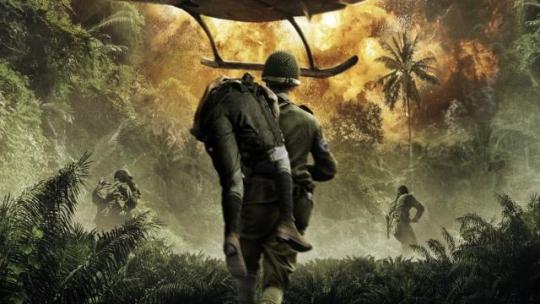
Opening in moderate release this weekend (theater count TBD) is filmmaker Todd Robinson’s THE LAST FULL MEASURE (Roadside Attractions), a military drama that the director has been trying to make for a decade. He’s pulled together an amazing cast that includes Christopher Plummer, Samuel L. Jackson, Ed Harris, Diane Ladd, Sebastian Stan, Bradley Whitford, Peter Fonda, William Hurt, Jeremy Irvine and Michael Imperioli. I still remember Robinson mentioning this project when I spoke to him for his excellent movie Lonely Heartswhen we spoke for ComingSoon.netway back in 2007, having seen that movie at the Tribeca Film Festival.
It involves a group of Vietnam vets trying to get a brave soldier, Airman William H. Pitsenberger Jr. (played by Irvine), the Medal of Honor for his actions on the battlefield to save them 34 years after his death. It sounds like a terrific premise, so it’s a movie I’ve been waiting to see for a very long time. I’m not sure exactly how many theaters Roadside Attractions will release the movie into, but I doubt it will be enough to get it into the top 10, as I think it will end up making $2 to 3 million at best. (This probably would have been a good movie to release over Veterans’ Day, but I guess it was afraid of Roland Emmerich’s Midway, which did end up winning that weekend.)
Mini-Review: It’s pretty obvious what a passion project this must have been for filmmaker Todd Robinson from the time it’s taken for him to get this movie made, but once watch how this story plays out, it’s much more obvious why he was so driven. Even fifty years after the events depicted in the film’s Vietnam War flashback
It’s 1999, and Sebastian Stan plays Scott Huffman, an Air Force attorney working at the Pentagon who is assigned the duty of investigating the heroics of Airman William H. Pitsenberger Jr., who dropped into one of the bloodiest battles of the Vietnam War to save a number of soldiers. William Hurt plays Tulley, the soldier that comes to Huffman, although the lawyer tries to put him off due to the upcoming regime change. Against his will, Scott has to pursue this endeavor, so he goes to interview a number of the living men who were there on that fateful day.
What’s amazing about Robinson’s film is that while it focuses mainly on Stan’s character, the various actors he meets on his journey deliver some absolutely amazing performances, from Christopher Plummer (as the dead airman’s dying father), Samuel L. Jackson, Ed Harris and the late Peter Fonda.
At its worst, The Last Full Measure veers into TV movie melodrama, so it takes some of the stronger actors to drag it back. The worst example of this are the scenes between Stan and his ersatz family, which seems the most like needless scenes added to create some sort of artistic license. It probably will be little surprise that many of the names and circumstances have been changed for similar reason.
It’s a shame that Roadside Attractions doesn’t have enough faith in this movie to give this a bigger push, instead dumping it into a January weekend with little fanfare. Sure, this is certainly the type of movie that cynical film critics like tearing apart, trying to find faults over the good…. And there’s a lot of good to be had. There’s no denying that this is an important story that needs to be told, and hopefully, the audiences that might appreciate it will be able to find it. Rating: 7.5/10
What should be interesting to see if the horror film The Turning does well enough to surpass Dolittle for third place or falls just short. Either way, Universal will have three movies in the top 5, which is quite remarkable considering what a horrid December the studio had.
This week’s Top 10 should look something like this…
1. Bad Boys for Life (Sony) - $29.5 million -53%
2. 1917 (Universal) - $13 million -41% (up 1 million)*
3. Dolittle (Universal) - $10.1 million -54%
4. The Turning (Universal) - $9.3 million N/A (up .2 million)*
5. The Gentlemen (STXfilms) - $8.6 million N/A (up .1 million)*
6. Jumanji: The Next Level (Sony) - $5 million -48%
7. Star Wars: The Rise of Skywalker (Lucasfilm/Disney) - $4 million -52%
8. Little Women (Sony) - $3.5 million -45%
9. Just Mercy (Warner Bros.) - $3.1 million -47%
10. Knives Out (Lionsgate) - $2.6 million -40%
- The Last Full Measure (Roadside Attractions) - $2 million N/A (down .5 million)*
* UPDATE: Not a ton of changes but mainly a little bit of tweaking due to revised theater counts
LIMITED RELEASES
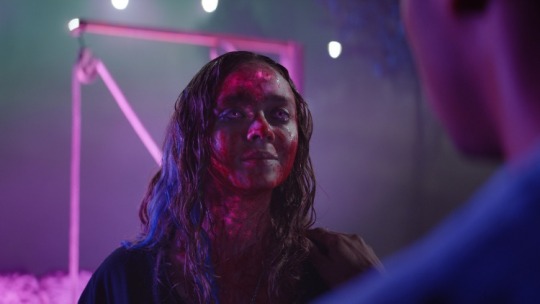
Not a ton of limited releases of note that I’ve seen, although I did see Richard Stanley’s sci-fi thriller COLOR OUT OF SPACE (RLJE Films), starring the one and only Nicolas Cage, and I even spoke to Stanley, an interview you’ll be able to read on Next Best Picturehopefully later this week. It’s based on HP Lovecraft’s short story, and in the movie, Cage plays an Alpaca farmer whose family is affected by a meteorite that falls on the property, causing all sorts of bizarre changes both mentally and physically. It’s another movie where Cage can go a little nuts, but I also liked the performances by Madeleine Arthur and Joely Richardson, who ALSO appears in The Turning this weekend. There are also some smaller roles from Q’orianka Kilcher (from Malick’s The New World) and the great comic, Tommy Chong. There will be a special screening tonight in select cities with a satellite QnA with Stanley and Cage, and then it opens for real Friday. Being RLJE, it should be On Demand shortly afterwards.
Oddly, I haven’t seen any of the movies in the franchise that brings us DETECTIVE CHINATOWN 3 (Wanda Pictures/WB International), but the previous installments of director Sicheng Chen’s police action-comedy must have done well enough for people to want to see more of detectives Tang Ren (Baoquiang Wang) and Qin Feng (Haoran Liu) to get a third movie. The first movie made $120.6 million worldwide while the sequel made $544 million, so yeah, a third movie was inevitable. The sequel made less than $2 million domestically but one can expect that Chinese audiences in America will help the third movie do similarly. For comparison, the latest installment of the Ip Man franchise, starring Donny Yen, has grossed $3.5 million in North America. This will open in about 150 theaters.
Sadly, I also didn’t get a chance to see Dante Lam’s The Rescue (CMC Pictures), the Chinese filmmaker’s follow-up to his global blockbuster Operation Red Sea, before writing this column, but this is clearly one of the major Chinese tentpoles being released for the Lunar New Year movie season. It stars Eddie Peng from Operation Mekong as the captain of an elite rescue team, and it’s shot by Crouching Tiger, Hidden Dragon’s Oscar-winning cinematographer Peter Pau. I’m hoping to see it this coming Friday.
Terry Crews stars as John Henry (Saban/Paramount) in Will Forbes, in this case Henry being an ex-gang member who puts aside his life of violence to take care of his aging father (played by Ken Foree from Dawn of the Dead )in South L.A. where he meets two immigrant kids on the run from his former gang leader (Ludacris), putting him in a tough spot. It will open in select cities and On Demand this Friday.
Bertrand Bonello, who made the excellent Nocturama a few weeks back, returns with his eighth feature Zombi Child (Film Movement), which is a very different take on the genre. It draws from the true story of Clairvius Narcisse, who was reportedly zombified in 1962 Haiti, this one centering around Narcisse’s (fictional) orphaned granddaughter who is trying to fit in with the mostly white girls at her boarding school. It will open in New York at the Quad Cinemaand at Lincoln Center.
Lastly, there’s the Bollywood film Panga (FIP) from director Ashwiny Iyer Tiwari, starring Kangana Ranaut as a middle-class Indian woman and former kabaddiworld champion looking for new meaning as a wife and mother, who decides to return to the sport despite her age and responsibility to family. It will open in roughly 100 theaters.
REPERTORY
METROGRAPH (NYC):
Opening Friday at the Metrograph is the 1stU.S. release of the director’s cut of Jia Zhangke’s 2010 documentary I Wish I Knew,which looks at the past and present of Shanghai in a documentary full of interviews with people from all different walks of life including local actresses and fellow filmmaker Hou Hsiao-hsien. It also follows Zhangke’s favorite actress Zhao Tao, who was amazing in last year’s Ash is Purest White, as she explores the site of the Shanghai World Expo Park as it’s under construction. It’s a great film to learn more about the history of mainland China, something I greatly appreciated having been such a longtime inhabitant of Chinatown.
Even more exciting is that the Metrograph is starting a retrospective series for indie filmmaker Hal Hartleythis Friday, which is exciting since I’ve been such a big fan but haven’t seen nearly as many of his films as there are out there, having only seen his debut The Unbelievable Truth (1989) a few years back, also at the Metrograph. Hal Hartley will be at the Metrograph this Friday night, January 24, and then back on February 1 for screenings of Henry Fool (1997) and its 2006 sequel, Fay Grim. This weekend, you can see Trust from 1990, Simple Men (1992), 1994’s Amateur and more.
With the nomination of Julia Reichert and Steven Bonar’s American Factory receiving an Oscar nomination, Metrograph has put together a last-minute series, “The Academy-Nominated Films of Julia Reichert and Steven Bognar,” a program of three shorts including the 2009 short The Last Truck(shown with American Factory), 1976’s Union Maids and 1971’s Growing Up Female, and the 2006 miniseries A Lion in the House.
This weekend’s Late Nites at Metrograph is the Jackie Chan action classic Police Story (1985). Oops, I made a little error as Playtime: Family Matinees, was supposed to be Taika Waititi’s 2016 film The Hunt for the Wilderpeople, but it got changed to Peter Weir’s 1989 movie Dead Poets Society, starring Robin Williams, which is also quite good.
ALAMO DRAFTHOUSE BROOKLYN (NYC)
Besides tonight’s “Weird Wednesday” of Brain Dead (1990), they’re doing a Troop Beverly Hills “Quote-Along” tomorrow night. If that isn’t good enough, on Monday, you can see the Lonely Island’s amazing Popstar: Never Stop Stopping either as part of the monthly “Out of Tune” hosted by my pal Jeremy Wein at 7pm or at 9:30 as a Sing-Along, well except that both are very close to sold out. Next week’s “Terror Tuesday” is the Japanese horror classic Ringu (1998) (I’ll be there) and then “Weird Wednesday” is 1979’s Killer Nun.
THE NEW BEVERLY (L.A.):
Wednesday’s “Afternoon Classics” is Ernest Borgnine’s 1955 film Marty, and then Weds. and Thurs’ night’s double feature is Bob & Carol & Ted & Aliceand Jacques Demy’s Model Shop, both from 1969. Friday’s “Freaky Friday”… um… “Afternoon Classics” is the 1985 vampire thriller Fright Night, and Friday night’s midnight screening is Tarantino’s Django Unchained. (The Saturday midnight screening of Scorsese’s Goodfellasis already sold out.) The weekend’s “Kiddee Matinee” is Miyazaki’s How’s Moving Castleand then the Monday Matinee is the 1971 thriller Klute. (Most of the weekend evening slots are taken up by Once Upon a Time … in Hollywood, just to make sure all the Oscar voters have a chance to see it in the next couple weeks.) Monday and Tuesday night is a Henry Hathaway double feature of The Lives of a Bengal Lancer(1935) and The Trailer of the Lonesome Pine (1936).
FILM FORUM (NYC):
While the “Black Women: Trailblazing African American Performers & Images, 1920 – 2001” continues this weekend with the 1934 and 1959 iterations of Imitation of Life, as well as screenings of What’s Love Got To Do with It, the Tina Turner biopic starring Angela Basset, who received an Oscar nomination for it, and then the Film Forum Jr. screening is The Wiz, starring Michael Jackson and Donna Summer. Other movies in the series include Cleopatra Jones, Gone with the Wind and Spike Lee’s debut She’s Gotta Have it. Film Forum is also doing a special Homage to Anna Karenina, the late Jean-Luc Godard muse who starred in many of his classics including Band of Outsiders, Alphaville, Pierrot Le Fou, plus six other films will be screened beginning Wednesday and through January 30. On Sunday, Film Forum is showing Lee Grant’s 2005 documentary A Father … a Son … Once Upon a Time in Hollywood, which is about Kirk and Michael Douglas with Grant in person doing a QnA. The theater will also screen William Wyler’s 1951 film Detective Story, which stars Grant on Sunday and next Tuesday.
EGYPTIAN THEATRE (LA):
This weekend begins “Cinematic Void 2020” with the Friday selection being Dario Argento’s The Cat O’Nine Tails (1971), followed on Saturday by a 5-movie Giallo Marathon, including Argento’s Opera(1987), Bava’s A Blade in the Dark (1983), Fulci’s The Black Cat (1981), and two more. Joe Dantewill be on Sunday for his 16mm Spotlight, showing 1972’s Richard. This week’s “Sunday Print Edition” is Carol Reed’s Night Train to Munich(1940) in 35mm in the afternoon and then Richard Benjamin and Dyan Cannon will be on hand to discuss the amazing 1973 thriller The Last of Sheila, one of my favorite movies.
AERO (LA):
Besides a matinee screening of Scorsese’s Goodfellas on Thursday (free to Cinemateque members), the AERO begins a “Ford Vs.” series with a double feature of John Ford’s The Quiet Man (1952) with Sam Peckinpah’s classic Straw Dogs (1971). Friday is Ford’ sStagecoach(1939) with Kelly Reichardt’s Meek’s Cutoff (2010). Saturday at 9AM, you can watch a triple-feature of Toy Story, Toy Story 2 and Toy Story 3, and then in the afternoon, the AERO will show Toy Story 4 with guests. That’s a full day of Toy Story viewing! Saturday night’s “Ford Vs.” is Ford’s The Man Who Shot Liberty Valance with Akira Kurosawa’s Sanjuro, both from 1962. Sunday night’s double is Sergio Leone’s Once Upon a Time in the West (1968) with Ford’s My Darling Clementine (1946). Tuesday’s Scorsese matinee is his debut Mean Streets.
QUAD CINEMA (NYC):
You can still catch a few of the movies in the lead-up to Bonello’s Zombi Child with another screening of I Walked with a Zombie on Weds. night, as well as De Palma’s Carrie and the Extended Director’s Cut of The Exorcist on Thursday.
MOMA (NYC):
Modern Matinees: Jack Lemmon will present the classic Billy Wilder film Some Like It Hot (1959) on Wednesday, Black Edwards’ The Great Race (1965) on Thursday and 1968’s The Odd Couple on Friday.
IFC CENTER (NYC)
This week’s Weekend Classics: Luis Buñuelwill screen a double feature of the classic short Un Chien Andalou (1929) with the doc L’Age D’or (1930) while Waverly Midnights: Hindsight is 2020s will screen Alfonso Cuaron’s Children of Men and Late Night Favorites: Winter 2020goes with Argento’s Suspiria… again.
MUSEUM OF THE MOVING IMAGE (NYC):
On Saturday, there will be a “Texas Chainsaw Double Feature” of the first two movies from 1974 and 1986 as part of the “Disreputable Series.” Also, the museum continues to screen Kubrick’s 2001: A Space Odyssey as part of its exhibition.
ROXY CINEMA(NYC)
The Nicolas Cage love continues on Weds. with Martin Scorsese’s 1999 movie Brinigng Out the Dead, and then on Saturday, Bottleneck Gallery will screen 1987’s The Monster Squad and 1986’s Night of the Creeps.
LANDMARK THEATRES NUART (LA):
Friday’s night’s midnight movie is John Carpenter’s adaptation of Stephen King’s Christine (1983).
FILM AT LINCOLN CENTER (NYC):
The New York Jewish Film Festival continues through next week so no rep stuff.
STREAMING AND CABLE
On Sunday, Netflix will stream the first season of Fast and Furious: Spy Racers, which I have little to no interest in. I have a little more interest in Star Trek: Picard, which will begin streaming on CBS All Access on Thursday.
That’s it for this week. Next weekend is the Super Bowl, but that’s not gonna stop the releases of Gretel and Hansel(U.A. Releasing) and Blake Lively’s The Rhythm Section (Pararamount).
0 notes
Text
The Weighing of the Heart by Paul Tudor Owen - New York book launch

Lyndsey Rodrigues interviews Paul Tudor Owen at the Clover Club
On 12 August 2019, I launched my novel The Weighing of the Heart in the US with a party at the Clover Club in Brooklyn. It was fantastic to see so many old friends from my time in New York.
TV host and writer Lyndsey Rodrigues interviewed me. You can watch a video of the launch below, and I’ve also posted a rough transcript.
Full details on the book from Obliterati Press here - or buy a copy from:
Amazon US
Amazon UK
Foyles
Waterstones
youtube
The Weighing of the Heart is set in New York - but the timeframe is before you moved here in 2015. How did you go about researching a New York that ‘pre-dates’ you, so to speak? The book starts in 2011, right? What made you decide to set the book in that timeframe?
So for those who don't know, The Weighing of the Heart is about a young British guy living in New York called Nick Braeburn, who moves in with a couple of rich older ladies as a lodger in their opulent apartment on the Upper East Side. He gets together with their other tenant, Lydia, who lives next door, and the two of them steal a priceless work of art from the study wall.
The work of art that Nick and Lydia take is an Ancient Egyptian scene, and as the stress of the theft starts to work on them, the imagery of Ancient Egypt, the imagery in the painting, starts to come to life around them, and it’s intended to be unclear whether this is something that is really happening or whether it’s all in Nick’s head.
And as most of you know my wife Eleanor and I have just come back from living in New York, where I was working for the Guardian newspaper.
But actually I started this book a long time before we moved here.
I’d had this longtime fantasy about living in New York, and in some ways the book was a way of living out that fantasy in fiction. I’d loved New York since I was a teenager reading The Great Gatsby and watching Mean Streets, and I’d first visited when I was 20 and studying at the University of Pittsburgh.
It just so happened that towards the end of writing the book I got the chance to move over here and life imitated art.
Suddenly I was walking the same streets my characters walked and especially in the first few weeks I did sometimes wonder if this was really happening. I don’t know if anyone remembers the 90s British sci-fi comedy series Red Dwarf, but there’s one episode where the main character, Lister, gets hooked on this computer game called Better Than Life, it’s like a fully immersive VR game, almost like The Matrix, and in the game he thinks he is living in Bedford Falls, the town from It’s a Wonderful Life, and he is loving it, he doesn’t want to leave – it’s better than life.
And sometimes when I first got here I got a bit worried that I was in Better Than Life, that I’d wake up and I’d be still a teenager in Manchester reading The Catcher in the Rye and The Great Gatsby, fantasising about living in New York.
In terms of depicting the city before I got here, I visited New York many times after first coming here in 2000, but there were definitely things that I got wrong.
I think generally before I moved here to me New York was Manhattan. And the earlier drafts of the book don't really mention the other boroughs at all.
And one thing I realised straight away when I moved here was that the cultural centre of gravity had quite a while ago moved to Brooklyn.
So the main location in the book is on the Upper East Side, and I didn’t change that. I thought that was still right for an apartment owned by a couple of wealthy sisters.
But a lot of the other Manhattan locations – like people’s apartments, artists’ studios, art galleries – in a lot of cases I just realised that the characters in the book wouldn’t be able to afford those places, so I moved them further afield, often across the river to Brooklyn.
Another example was the Peacocks’ second home. In the book the Peacocks, the elderly ladies Nick moves in with, have another home on Long Island that they live in most of the week. For ages I had it that this place was in Montauk, but eventually we actually went to visit Montauk, and it just didn’t seem suitable… As we were driving in, I had this old guide book that was about 10 or 15 years old, and Eleanor was reading it as we drove in, and it said something like: ‘Montauk is a quiet, deserted spot that receives few visitors,’ and we were just driving past all these 40-storey hotels and golf resorts, and it just didn’t feel right at all. On top of all the tourism, it was just too weatherbeaten and remote for the Peacocks.
And then some friends of ours bought a place in Water Mill and I looked the town up and it just seemed like a great fit for the Peacocks, great location, perfect distance from Manhattan, so I moved them from Montauk to Water Mill, and they seemed much happier there immediately.

One of the first lines of the book is: ‘Sooner or later, everybody comes to New York...’ How important are the themes of reinvention and redemption to the book? Did reinvention play a part for you in your decision to move to NYC?
I like that first line of Nick’s narration because at first glance it sounds like he’s saying something reasonable and unremarkable but actually it sort of establishes his solipsism and self-obsession early on. Nick is obsessed with reinventing himself and using New York as a vehicle for that and he assumes everybody else feels the same way.
I’ve moved to the US twice – the first time was when I was 20 and I came over to study for a year at the University of Pittsburgh. Moving over then, at that age, I definitely felt like this was a place where I could reinvent myself. That was a big part of the attraction. And I met people who wanted to be writers and actors and musicians and I definitely felt that instead of those things seeming somewhat out of reach, as they had back home in the UK, these were actually real and achievable goals here, and I found that really inspiring. It had a big impact on me. And a lot of those people did go on to achieve those goals.
And when I moved back to the US in 2015 I definitely felt excited again about this prospect of reinventing myself. But I think there’s a real difference doing that at age 35 to doing it at age 20. At age 20 you’re still something of a blank slate. At 35, to a certain extent you’ve reached a point where you’re more confident about who you want to be and how you want other people to see you. And over a process of years you’ve reached a point where you know how to project that – to a certain extent anyway. And I think something I underestimated was that it’s quite a tough job to start from scratch with all new people in a new country and start to try to create that impression again.
With Nick, in the book, this is an example of me taking one of my own characteristics and really taking it to an extreme with Nick. Nick has a much more extreme attitude towards reinvention than me. He’s taken it to an unhealthy degree. He hasn’t just left England – he’s completely abandoned it and never goes back. He says at one point it’s hard to imagine England even still exists. He never speaks to his parents. And when he gets the chance to live in this opulent apartment on the Upper East Side and gets together with Lydia, he very quickly abandons his old life in Greenpoint, and the friends that he mentions in the first couple of chapters gradually drop out of the story. He takes it to a real extreme.
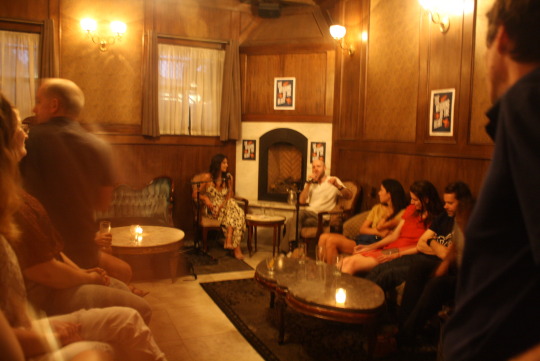
Let's talk about the Ancient Egyptian theme that runs through the book and particularly the actual ceremony of the weighing of the heart – what drew you to this as the perfect anchoring point of the book?
So, yeah, the other big theme of the book, as well as New York, is Ancient Egypt. The work of art that Nick and Lydia steal is an Ancient Egyptian scene, and this imagery comes to life around them.
But originally the artwork wasn’t an Ancient Egyptian scene at all; it was a 1960s pop art work. But not long after I had started the book I went to a fascinating exhibition at the British Museum called The Ancient Egyptian Book of the Dead, which told the story of what the Ancient Egyptians believed happened to you when you die.
As I learnt from the exhibition, the Ancient Egyptians believed in a ceremony called ‘the weighing of the heart’, something in some ways similar to the Christian idea of St Peter standing at the gates of Heaven, deciding whether or not you have lived a worthy enough life to come in.
In the Ancient Egyptian version, Anubis, the god of embalming, presides over a set of weighing scales, with the heart of the dead person on one side and a feather on the other.
If the heart is in balance with the feather, you get to go to Heaven, which they called the Field of Reeds.
But if your heart is heavier than the feather, you get eaten by an appalling monster called the Devourer, who has the head of a crocodile, the body of a lion, and the back legs of a hippopotamus – three of the most dangerous creatures that Ancient Egyptians could encounter.
To the Ancient Egyptians, the heart, rather than the brain, was the home of a person’s mind and conscience and memory, which was why it was the heart they were weighing.
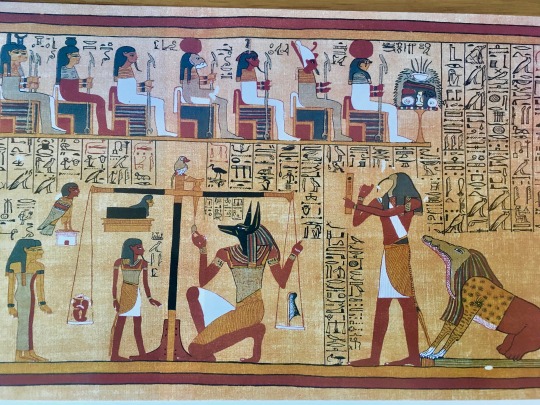
The Ancient Egyptian ceremony of the weighing of the heart
And, intriguingly, one thing they were afraid of was that the heart would actually try to rat you out during this ceremony – sometimes the heart would speak up and reveal your worst sins to Anubis at this crucial moment. You could prevent this from happening by keeping hold of a little ‘heart scarab’.
And I suddenly realised that the painting Nick and Lydia should steal should be an image of this ceremony, the weighing of the heart. It was so fitting, because the book is essentially about guilt and innocence; it’s about you weighing up as a reader how much you trust Nick as a narrator, and it’s about Nick himself and the people around him weighing up how much they trust him, what they think of him, what they know about him and his character. And without spoiling it for anyone who hasn’t read it, I hope that I found a way to knit all that imagery into the book effectively, especially towards the end.
Once I’d settled on this, there was another strange example of life imitating art.
At one point in The Weighing of the Heart Nick recalls a school trip to the British Museum, and it is suggested he might have stolen one of these heart scarabs that could protect you during the ceremony. I had written this scene but I wanted to get the details right, so I looked through the British Museum’s collection of scarabs on their website and identified the one that best fit the bill, and then I went down to the museum to take a look at it in person.
But when I got there and found the case where this scarab was supposed to be, the space for this scarab was empty. Instead of the object itself there was just a note on the wall that said: ‘Heart scarab (lost).’ It was gone.
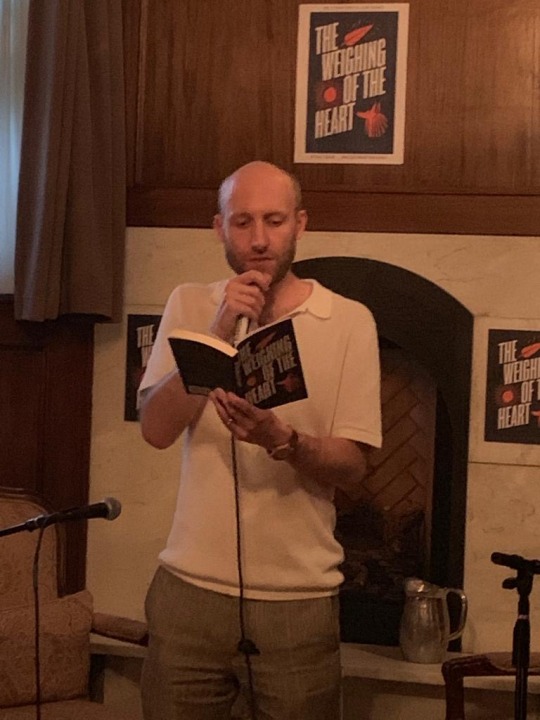
Paul Tudor Owen reading from his novel The Weighing of the Heart
There is a reference in the book about 9/11 and that being what Nick can pinpoint as transition from a Brit to a New Yorker – what was that moment for you?
I think one of the things London and New York have in common is that you can become a Londoner and you can become a New Yorker. I’m from Manchester – I don’t think you can really become a Mancunian. My parents have lived there for over 40 years but neither of them were born there and I don’t think they would say they were Mancunians.
But I think London and New York, because they are these melting-pot cities that people come to from all over the world, and all over the country, I feel like you can become a Londoner and you can become a New Yorker.
When I moved to London in the early 2000s I immediately felt very much at home there and excited by it for some of the same reasons I love New York – this mix of ambitious, exciting creative people, the feeling that you are right at the heart of things. And I felt like I quickly became a Londoner as well as a Mancunian. I was both.
And I thought when we moved to New York that might happen here – that I might start to become a New Yorker. But it didn’t really happen. And I was thinking about that and about my obsession with New York and wanting to write about it and depict it. And maybe what I want from New York is really to be an observer of it, rather than to truly become part of it.
I want to touch on a particular paragraph from the book that really spoke to me. Nick says: ‘If I carried on reaching out to this city, if I carried on giving so much, eventually it would give something back. But it never did.’ How much of your own feelings about NYC are reflected in these words?
I think I wrote that line before moving here, but it does ring true. I had an amazing few years here personally and professionally but I definitely felt like I didn’t break America, you know. You can count the number of people who do on one hand – it’s like the Beatles, One Direction and James Corden. Ed Sheeran.
I think moving to New York and living and working in New York for three years – from a British perspective that’s a very interesting thing to do. But from a New York perspective, it’s like: so what, who cares, big whoop. So you came to New York – who didn’t?
One of the first things that happened when I moved here was a building actually blew up on my block – it was completely levelled. I could see the fire burning from my fire escape. It was like: “Welcome to New York.”
There’s an artwork I really like by Raymond Pettibon that shows a silhouette of the New York skyline, and underneath it Pettibon has written: “Gotham City – the city that does not care.” There’s something in that. It’s a tough city. But that’s why we like it. It’s as hard as nails.

Tell us about the process of getting this book published. How many places did you pitch it to before Obliterati picked it up?
I had been writing fiction and trying to get published since my early 20s, when I managed to get an agent and finished a draft of a novel. He was very encouraging and sent it out to publishers, but none of them took it up.
So I kept on writing and working on ideas, and eventually around 2011 I started what was going to eventually become The Weighing of the Heart.
I think once I’d written the first couple of chapters I quickly felt quite confident that what I was writing now was much better than anything that I’d written before. I was particularly pleased with the set-up, which I thought was quite gripping immediately.
So I went back to my agent with what I’d written, but by this time, because of the unenthusiastic previous responses, he had more or less lost interest.
So I was faced with a choice. You’re usually told as an author – especially when you’re starting out – that you will never get anywhere without an agent, and that if you have managed to get one you should do everything you can to keep them.
I’m sure there is a lot of truth in that. But I felt that if I stayed with this agent, that was not going to result in this book getting published.
So I amicably cut ties with him and set about trying to find someone new. And luckily that turned out to be a much easier process than it had been in my early 20s. In those days agents had all expected manuscripts to be delivered by post, and I remember every weekend printing out page after page of my chapters, stapling these bundles together, taking them to the post office... It was so time-consuming.
But by the time I came to find a new agent, email had vastly simplified the whole system. I finished work one day and went to a secluded spot in the office, and started working my way from A to Z through The Writers’ and Artists’ Yearbook, which lists all the agents in the UK, sending out my first two chapters to as many agents as I could. I think that first night I got about half way through the alphabet, to about M, and by the next morning, or the morning after that, I was already getting some interest, which was really heartening.
And I eventually started working with a brilliant agent called Maggie Hanbury, who I’m still working with now, and I finished a workable draft of The Weighing of the Heart and we started sending it out.
But at that point I had a stroke of bad luck. Another book about art theft in New York – The Goldfinch by Donna Tartt – had just come out, and it was a massive hit. It was everywhere. Again and again I heard from publishers: “We really like your book, but it’s just too similar to The Goldfinch.”
And shortly after that I moved to New York and started a new job and life had become extremely busy and complicated, and I don’t think I did any work on the novel or on trying to get it published for the next year or so.
When things started to settle down a bit, I went back to my agent, but she said she didn’t feel that she could send it out to anyone else because a number of publishers had turned it down already.
So again I was faced with a choice. I could just leave the manuscript in my metaphorical desk drawer and get on with something else. But I knew that it was a good book and it felt frustrating that it was sitting there, unread.
So I decided to send it out to small publishers myself. And again I went through The Writers’ and Artists’ Yearbook and the US equivalent, Writers’ Market, starting at A and sending out the first two chapters to as many publishers as I could.
And the response was very positive. The received wisdom in the literary world is that publishers will only talk to you if you’ve gone through an agent, and that may well be true for the big publishing houses. But many smaller presses seemed happy to consider my book without an agent being involved.
I had a really productive discussion with Obliterati Press, a small publishing house in the UK set up by two writers whose whole purpose is to get books out there that they feel enthusiastic about, which otherwise might not see the light of day. They agreed to publish it, and it was a great process working with them.
My publication date ended up roughly coinciding with our return to London from New York – and it felt very exciting to be coming back to the UK ready to achieve this ambition that I had been working towards for so long.
What is your process for overcoming the dreaded writers’ block?
I think because of my journalistic background I find that if I get stuck on a plot point or a bit of the writing I’m not sure about, I am usually able to just get on with it and get from A to B in a pretty straightforward, basic fashion, and then go back and return to it and finesse it at a later date. I think that comes from working to constant deadlines and strict deadlines in my day job. I can sort of get on with it.
My usual way of working is, I usually work at the kitchen table with a cup of tea and a glass of squash… This isn’t a Charles Bukowski-type situation where I’m downing shots of whiskey and then furiously tapping out whatever drunken visions come to me.
But I am very easily distracted and it’s not always great trying to work at home. I’ll go and water the plants or tidy something up or sort my books out… There’s a cliché about writers’ homes, that they are very tidy because the writer who claims that they were spending the day writing has actually been pottering about tidying everything up. I’m sure Charles Bukowski had that problem too.
When we were in New York I couldn’t really work at home because we only had a small apartment, so I needed to find somewhere else to go.
The Guardian’s office was in a WeWork co-working space, so that meant I could book rooms in any WeWork around the city and I used to do that on a Saturday or a Sunday and go and write there.
And I would go to a different WeWork each time, which was great because I really got to explore the city and work in lots of different places, and it was brilliant to feel immersed in New York and to be seeing the sights of the city out of the window as I was working. I would try to find WeWorks that were as high up as possible with the best views. There was one office in Midtown that I really liked with a great view right down into the forest of skyscrapers. At another one in Tribeca, I came downstairs once at about 5pm and the other WeWorkers were having a rave on the ground floor, all like scooting around on hoverboards or those one-wheel motorised unicycles – you know what they’re like. Drinking beer from red plastic cups. And like a couple of guys would be asleep on the sofas, snoring. Whenever you go to a WeWork there’s always some guy asleep. He’s paying like $400 a month for his membership and he’s fast asleep.

The view from one of the WeWorks where Paul would go to write
What are you planning to write next?
I’ve just finished the first draft of my next book but it still needs a lot of work. It’s set in New York again but it’s going to be set in the 1970s when New York was a sort of crime-plagued hellhole. And I think that that was the kind of New York that I first fell in love with through films like Taxi Driver and Mean Streets.
To me that was a time when New York felt so exciting but also so gritty and I really wanted to sort of conjure up that New York in my writing. It’s about a failing newspaper journalist in New York who starts looking into conspiracy theories about the moon landings and he starts meeting these conspiracy theorists who believe the moon landings were faked and as he gets drawn into deeper into the world he sort of finds himself against his better judgment starting to believe some of their paranoia.
#book launch#paul tudor owen#weighing of the heart#ancient egypt#new york#brooklyn#nyc#new york city#novels#books#authors
0 notes
Text
Log 0.6
Kyoto (京都市) in a day, pt.1
July 16, 2016
This weekend was one of the few in which my host dad could come back from work and spend time at home. He and my host mum planned to take the family (minus Shunto) out to visit Kyoto, one of Japan’s most sought after tourist destinations for its rich history as the old capital city.
We left the house at around 9:55 am in order to catch the 10:05 bus. While we were waiting at the bus station, a lady came over to ask me when the bus was coming. I panicked because I knew what time it was supposed to come but I didn’t know how to tell it to her (or at least the words weren’t coming together in my head quickly enough). Instead, I desperately redirected her to my host dad who was able to tell her what I couldn’t.
At Mikage station, I had a short conversation with my host dad while we were waiting for our train. He asked me if I knew what mikageishi (御影石) was and told me that it is the Japanese word for granite stone. I learned that the area we lived in was named after its mineral relation to local sake breweries. The Mikage area, named after its rich granite supply, was known to produce some of the best sake because of its hard, mineral-rich water. He used a word to describe the water which I think was namasui (生水), but I’m not entirely sure.
From Mikage station, we rode to Okamoto station and transferred onto a longer distance train to Kyoto. On this train, we passed through downtown Osaka where there’s a massive electronics sector. Here is a short video clip of some of the scenery we were passing by on the train. Everything looks so beautifully lush and green.
youtube
My host dad also shared some snacks with us on the train. We had some Tanabata-themed Koala March cookies and Puré sour gummies. I’ve discovered that these gummy snacks are probably my favorite sour candy. Somehow they are very sour without being overpoweringly sweet. And they are on the chewy side rather than being extremely squishy and sticky which is a plus.
A quick detour to talk about special edition snacks: The Koala March cookies were adorable in that they featured Koala characters dressed as Hikoboshi and Orihime with stars and other Tanabata decorations. Even in the Puré gummies which were all cut in circular shapes, I found a special heart-cut gummy which I’m pretty sure was rare and supposed to be auspicious. I love these small details.

We arrived in Kyoto and began walking around. Here’s a map of the area we arrived in. There’s so much to see!

Our first stop was Fushimi inari taisha (伏見稲荷大社), the head shrine in Inari, Fushimi prefecture. The Shinto shrine is dedicated to Inari (稲荷大神), the god of rice, sake, agriculture/industry, and prosperity who takes the shape of a fox.
One thing about keeping a journal that I’ve found to be quite difficult is recording down emotion and detail. Through the pictures that I have taken, I can easily picture the places I’ve been but it’s hard to recapture the initial feeling of amazement I felt when I was walking around these places and taking photos. I’m trying my best.
In any case, the photo below is of the wall of donors that helped the development of this shrine and its surrounding area. My host dad chuckled a bit when he saw I was trivially taking a photo of this but I really love the wooden nameplate’s aesthetic.
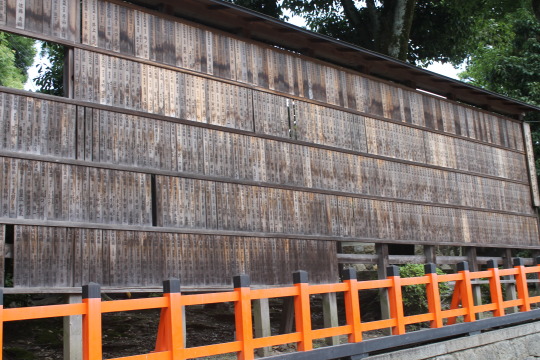
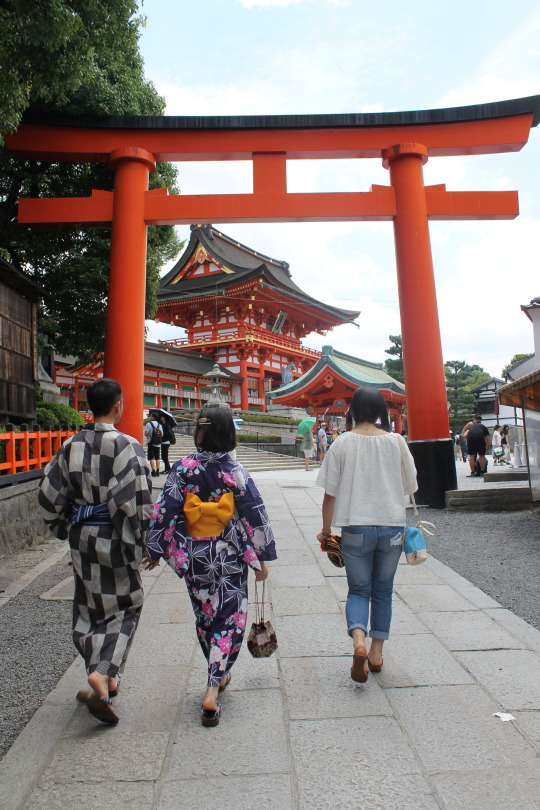

Here is the main area of the shrine. Look at the kitsune (狐) fox guardian statues! Because Inari takes the form of a fox, this shrine is dedicated to fox symbolism.
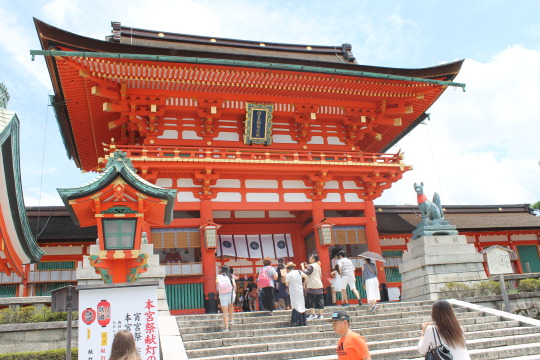
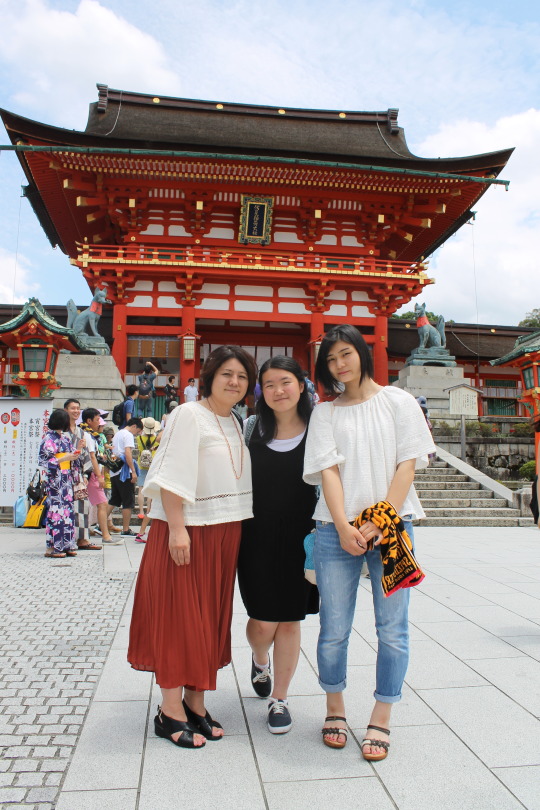
The grounds of the shrine are divided up into several different areas that seem to be dedicated to different things. In the picture below, you can see that we visited one of the shrine’s areas to wish for good luck for Fumina’s exchange year to America. This area, if I remember correctly, is dedicated to education and children’s health.

So many senbazura (千羽鶴) chains! A thousand folded paper cranes is a well-known symbol of good luck in Japan. The cranes are occasionally made and assembled like the ones below to wish good luck to a person or for a certain cause. I’ve never seen so many in one place!

This is the beginning of one of the pathways of torii (鳥居) shrine gates. Fushimi inari taisha is most well-known for its thousands upon thousands of torii gates. The gates, stacked each against one another, run for miles along pathways that curve and twist up the mountain. They are each donated to the shrine by wealthy Japanese businesses that can get their names engraved on the sides of the gate for blessings of continued wealth and prosperity.

While walking through the gates, my host dad lent me a folding fan to keep cool while walking. The temperature was pretty high that day so I was really grateful he brought a spare especially for me.
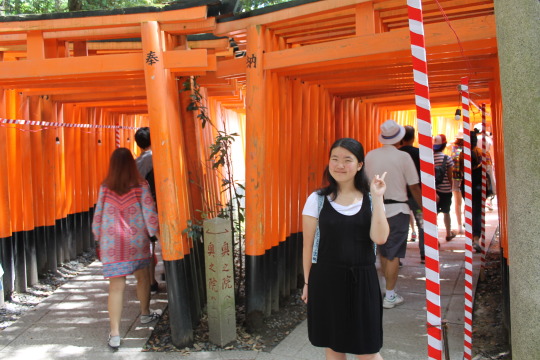
After walking through a lot of gates, we arrived at a small clearing where there were more things to look at. A reasonably large line of people had formed around the area picture below with my host father. Essentially it was a station with two stones that could predict the stress levels of your future.
The idea is that you approach either one of the stones and think about something in the future that you are thinking of doing or accomplishing. Immediately after, you must attempt to pick up the stone and if it seems lightweight and easy to pick up, your wish will be naturally fulfilled with time. However, if you struggle to pick it up and you think it is rather heavy, then you may want to reconsider your goal.

In this area and many other areas surrounding this one, there are little areas to put down mini torii gates (which can be purchased) for good luck.
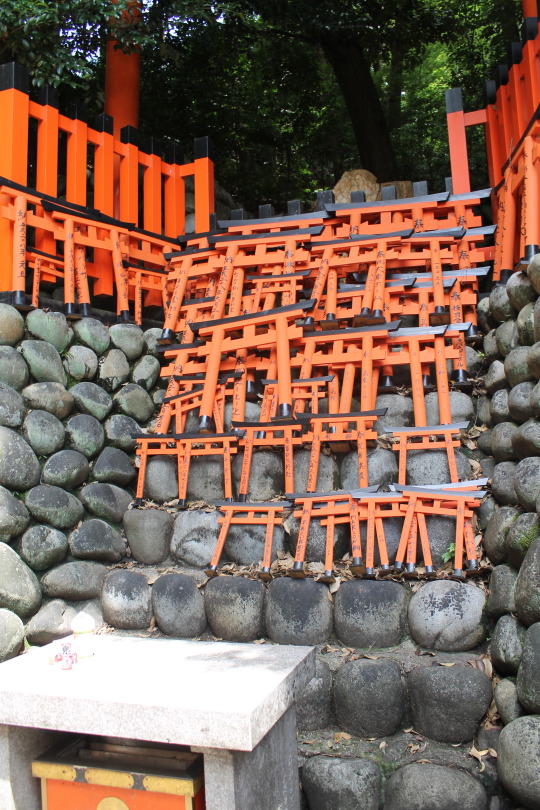

After walking around Fushimi inari, we began heading towards our second destination of the day.

Sanjuusangendou (三十三間堂) is a Buddhist temple that is well-known for housing 1001 carved golden statues of Kannon, the goddess of mercy. The building is long (and my picture only captures about half of it from the side) and features an entrance and exit on only one end of the building.
Before entering the main temple building, all visitors must take off their shoes which can be placed in storage cubbies at the entrance.

While pictures of the statues are no longer permitted inside the building, there are many images online that depict its splendor.

When I walked into the building, I took notice of the air which was thick with the smell of burning incense. It was quiet and somewhat worldly-feeling inside. As I walked through, I stopped to examine each of the statues and what they were supposed to represent. The intricacy of the way the characters were carved really struck a cord with me. I think art is powerful.

Next to the main building, there is a small garden. I caught a quick glimpse of some cranes wading in the water as I walked around.


By the time we left Sanjuusangendou, it was around noon. My host dad suggested to find some food in the area so we began walking around for places to eat.
Continued in pt.2!
0 notes